Combining InSAR Technology to Uncover the Deformation Factors and Mechanisms of Landslides in the Baihetan Hydropower Station Reservoir Area
Abstract
1. Introduction
2. Study Area and Methods
2.1. Study Area
2.2. InSAR Data Acquisition and Processing
2.3. Investigation and Testing of “Prone-Slide” Layers
3. Results
3.1. Identification of Deformation Zones and Landslides
3.2. “Prone-Slide” Layer Distribution and Swelling Behavior
4. Discussion: Impact of Faults and Earthquakes on Landslides
5. Conclusions
Author Contributions
Funding
Data Availability Statement
Conflicts of Interest
References
- Penghao, C.; Pingkuo, L.; Hua, P. Prospects of Hydropower Industry in the Yangtze River Basin: China’s Green Energy Choice. Renew. Energy 2019, 131, 1168–1185. [Google Scholar] [CrossRef]
- Owusu, P.A.; Asumadu-Sarkodie, S. A Review of Renewable Energy Sources, Sustainability Issues and Climate Change Mitigation. Cogent Eng. 2016, 3, 1167990. [Google Scholar] [CrossRef]
- Feng, S.; Guo, F.; Hu, J. Research on Multi-Energy Complementary Clean DC Delivery Considering Sending-End Resources and the Matching Mode of Receiving-End Peak Load Regulation. In Proceedings of the 2nd International Conference on Electronic Materials and Information Engineering, EMIE 2022, Hangzhou, China, 15–17 April 2022; pp. 1–17. [Google Scholar]
- Li, X.-Z.; Chen, Z.-J.; Fan, X.-C.; Cheng, Z.-J. Hydropower Development Situation and Prospects in China. Renew. Sustain. Energy Rev. 2018, 82, 232–239. [Google Scholar] [CrossRef]
- Li, L.; Yao, X.; Yao, J.; Zhou, Z.; Feng, X.; Liu, X. Analysis of Deformation Characteristics for a Reservoir Landslide before and after Impoundment by Multiple D-InSAR Observations at Jinshajiang River, China. Nat. Hazards 2019, 98, 719–733. [Google Scholar] [CrossRef]
- Shen, T.; Wang, Y.; Huang, Z.; Li, J.; Zhang, X.; Cao, W.; Gu, J. Formation Mechanism and Movement Processes of the Aizigou Paleolandslide, Jinsha River, China. Landslides 2019, 16, 409–424. [Google Scholar] [CrossRef]
- Gu, Z.; Yao, X.; Li, C.; Zhu, X. Driving Effects of Dynamic Geomorphologic Environments on Gravitational Erosion Hazards: A Case of the Baihetan Drainage Area of the Jinsha River, China. Bull. Eng. Geol. Environ. 2023, 82, 49. [Google Scholar] [CrossRef]
- Zhu, Y.; Yao, X.; Yao, L.; Zhou, Z.; Ren, K.; Li, L.; Yao, C.; Gu, Z. Identifying the Mechanism of Toppling Deformation by InSAR: A Case Study in Xiluodu Reservoir, Jinsha River. Landslides 2022, 19, 2311–2327. [Google Scholar] [CrossRef]
- Yang, Y.; Zhou, L.; Zhu, L.; Liu, W.; Wang, J. Impact of Upstream Reservoirs on Geomorphic Evolution in the Middle and Lower Reaches of the Yangtze River. Earth Surf. Process. Landf. 2023, 48, 582–595. [Google Scholar] [CrossRef]
- Zhang, M.; Ge, S.; Yang, Q.; Ma, X. Impoundment-Associated Hydro-Mechanical Changes and Regional Seismicity Near the Xiluodu Reservoir, Southwestern China. J. Geophys. Res. Solid Earth 2021, 126, e2020JB021590. [Google Scholar] [CrossRef]
- Ruiz-Villanueva, V.; Allen, S.; Arora, M.; Goel, N.K.; Stoffel, M. Recent Catastrophic Landslide Lake Outburst Floods in the Himalayan Mountain Range. Prog. Phys. Geogr. 2017, 41, 3–28. [Google Scholar] [CrossRef]
- Cui, P.; Peng, J.; Shi, P.; Tang, H.; Ouyang, C.; Zou, Q.; Liu, L.; Li, C.; Lei, Y. Scientific Challenges of Research on Natural Hazards and Disaster Risk. Geogr. Sustain. 2021, 2, 216–223. [Google Scholar] [CrossRef]
- Lacroix, P.; Handwerger, A.L.; Bièvre, G. Life and Death of Slow-Moving Landslides. Nat. Rev. Earth Environ. 2020, 1, 404–419. [Google Scholar] [CrossRef]
- Yao, W.M.; Li, C.D.; Zuo, Q.J.; Zhan, H.B.; Criss, R.E. Spatiotemporal Deformation Characteristics and Triggering Factors of Baijiabao Landslide in Three Gorges Reservoir Region, China. Geomorphology 2019, 343, 34–47. [Google Scholar] [CrossRef]
- Dykes, A.P.; Bromhead, E.N. The Vaiont Landslide: Re-Assessment of the Evidence Leads to Rejection of the Consensus. Landslides 2018, 15, 1815–1832. [Google Scholar] [CrossRef]
- Ling, S.; Sun, C.; Li, X.; Ren, Y.; Xu, J.; Huang, T. Characterizing the Distribution Pattern and Geologic and Geomorphic Controls on Earthquake-Triggered Landslide Occurrence during the 2017 Ms 7.0 Jiuzhaigou Earthquake, Sichuan, China. Landslides 2021, 18, 1275–1291. [Google Scholar] [CrossRef]
- Sun, C.; Ling, S.; Wu, X.; Li, X.; Chen, J.; Jiang, W. Oxidation of Black Shale and Its Deterioration Mechanism in the Slip Zone of the Xujiaping Landslide in Sichuan Province, Southwestern China. Catena 2021, 200, 105139. [Google Scholar] [CrossRef]
- Schäbitz, M.; Janssen, C.; Wenk, H.R.; Wirth, R.; Schuck, B.; Wetzel, H.U.; Meng, X.; Dresen, G. Microstructures in Landslides in Northwest China—Implications for Creeping Displacements? J. Struct. Geol. 2018, 106, 70–85. [Google Scholar] [CrossRef]
- Zhang, S.; Xu, Q.; Hu, Z. Effects of Rainwater Softening on Red Mudstone of Deep-Seated Landslide, Southwest China. Eng. Geol. 2016, 204, 1–13. [Google Scholar] [CrossRef]
- Strauhal, T.; Zangerl, C.; Fellin, W.; Holzmann, M.; Engl, D.A.; Brandner, R.; Tropper, P.; Tessadri, R. Structure, Mineralogy and Geomechanical Properties of Shear Zones of Deep-Seated Rockslides in Metamorphic Rocks (Tyrol, Austria). Rock Mech. Rock Eng. 2017, 50, 419–438. [Google Scholar] [CrossRef]
- Alberti, S.; Wang, G.; Dattola, G.; Crosta, G.B. Physical Mechanical Characterization of a Rockslide Shear Zone by Standard and Unconventional Tests. Landslides 2019, 16, 739–750. [Google Scholar] [CrossRef]
- Wang, F.; Zhang, Y.; Huo, Z.; Peng, X.; Wang, S.; Yamasaki, S. Mechanism for the Rapid Motion of the Qianjiangping Landslide during Reactivation by the First Impoundment of the Three Gorges Dam Reservoir, China. Landslides 2008, 5, 379–386. [Google Scholar] [CrossRef]
- Dai, K.; Chen, C.; Shi, X.; Wu, M.; Feng, W.; Xu, Q.; Liang, R.; Zhuo, G.; Li, Z. Dynamic Landslides Susceptibility Evaluation in Baihetan Dam Area during Extensive Impoundment by Integrating Geological Model and InSAR Observations. Int. J. Appl. Earth Obs. Geoinf. 2023, 116, 103157. [Google Scholar] [CrossRef]
- Yi, X.; Feng, W.; Wu, M.; Ye, Z.; Fang, Y.; Wang, P.; Li, R.; Dun, J. The Initial Impoundment of the Baihetan Reservoir Region (China) Exacerbated the Deformation of the Wangjiashan Landslide: Characteristics and Mechanism. Landslides 2022, 19, 1897–1912. [Google Scholar] [CrossRef]
- Bolin, H.; Yueping, Y.; Renjiang, L.; Peng, Z.; Zhen, Q.; Yang, L.; Shulou, C.; Qiuwang, L.; Kaikai, X. Three-Dimensional Experimental Investigation on Hazard Reduction of Landslide-Generated Impulse Waves in the Baihetan Reservoir, China. Landslides 2023, 20, 2017–2028. [Google Scholar] [CrossRef]
- Zhang, S.; Sui, L.; Zhou, R.; Xun, Z.; Du, C.; Guo, X. Mountainous SAR Image Registration Using Image Simulation and an L2E Robust Estimator. Sustainability 2022, 14, 9315. [Google Scholar] [CrossRef]
- Li, M.; Zhang, L.; Yang, M.; Liao, M.J.E.G. Complex Surface Displacements of the Nanyu Landslide in Zhouqu, China Revealed by Multi-Platform InSAR Observations. Eng. Geol. 2023, 317, 107069. [Google Scholar] [CrossRef]
- Dai, K.; Li, Z.; Xu, Q.; Bürgmann, R.; Milledge, D.G.; Tomas, R.; Fan, X.; Zhao, C.; Liu, X.; Peng, J.J.I.G.; et al. Entering the Era of Earth Observation-Based Landslide Warning Systems: A Novel and Exciting Framework. IEEE Geosci. Remote Sens. Mag. 2020, 8, 136–153. [Google Scholar] [CrossRef]
- Wang, Y.; Dong, J.; Zhang, L.; Deng, S.; Zhang, G.; Liao, M.; Gong, J. Automatic Detection and Update of Landslide Inventory before and after Impoundments at the Lianghekou Reservoir Using Sentinel-1 InSAR. Int. J. Appl. Earth Obs. Geoinf. 2023, 118, 103224. [Google Scholar] [CrossRef]
- Qu, F.; Lu, Z.; Zhang, Q.; Bawden, G.W.; Kim, J.-W.; Zhao, C.; Qu, W. Mapping Ground Deformation over Houston–Galveston, Texas Using Multi-Temporal InSAR. Remote Sens. Environ. 2015, 169, 290–306. [Google Scholar] [CrossRef]
- Zhou, C.; Gong, H.; Chen, B.; Li, X.; Li, J.; Wang, X.; Gao, M.; Si, Y.; Guo, L.; Shi, M.; et al. Quantifying the Contribution of Multiple Factors to Land Subsidence in the Beijing Plain, China with Machine Learning Technology. Geomorphology 2019, 335, 48–61. [Google Scholar] [CrossRef]
- Chen, B.; Gong, H.; Chen, Y.; Li, X.; Zhou, C.; Lei, K.; Zhu, L.; Duan, L.; Zhao, X. Land Subsidence and Its Relation with Groundwater Aquifers in Beijing Plain of China. Sci. Total Environ. 2020, 735, 139111. [Google Scholar] [CrossRef] [PubMed]
- Dong, J.; Liao, M.; Xu, Q.; Zhang, L.; Tang, M.; Gong, J. Detection and Displacement Characterization of Landslides Using Multi-temporal Satellite SAR Interferometry: A Case Study of Danba County in the Dadu River Basin. Eng. Geol. 2018, 240, 95–109. [Google Scholar] [CrossRef]
- Dong, J.; Zhang, L.; Li, M.; Yu, Y.; Liao, M.; Gong, J.; Luo, H. Measuring Precursory Movements of the Recent Xinmo Landslide in Mao County, China with Sentinel-1 and ALOS-2 PALSAR-2 Datasets. Landslides 2018, 15, 135–144. [Google Scholar] [CrossRef]
- Xun, Z.; Zhao, C.; Kang, Y.; Liu, X.; Liu, Y.; Du, C. Automatic Extraction of Potential Landslides by Integrating an Optical Remote Sensing Image with an InSAR-Derived Deformation Map. Remote Sens. 2022, 14, 2669. [Google Scholar] [CrossRef]
- Xie, L.; Xu, W.; Ding, X.; Bürgmann, R.; Giri, S.; Liu, X. A Multi-Platform, Open-Source, and Quantitative Remote Sensing Framework for Dam-Related Hazard Investigation: Insights into the 2020 Sardoba Dam Collapse. Int. J. Appl. Earth Obs. Geoinf. 2022, 111, 102849. [Google Scholar] [CrossRef]
- Dun, J.; Feng, W.; Yi, X.; Zhang, G.; Wu, M. Detection and Mapping of Active Landslides before Impoundment in the Baihetan Reservoir Area (China) based on the Time-Series InSAR Method. Remote Sens. 2021, 13, 3213. [Google Scholar] [CrossRef]
- Berardino, P.; Fornaro, G.; Lanari, R.; Sansosti, E. A New Algorithm for Surface Deformation Monitoring Based on Small Baseline Differential SAR Interferograms. IEEE Trans. Geosci. Remote Sens. 2002, 40, 2375–2383. [Google Scholar] [CrossRef]
- Tizzani, P.; Berardino, P.; Casu, F.; Euillades, P.; Manzo, M.; Ricciardi, G.; Zeni, G.; Lanari, R. Surface Deformation of Long Valley Caldera and Mono Basin, California, Investigated with the SBAS-InSAR Approach. Remote Sens. Environ. 2007, 108, 277–289. [Google Scholar] [CrossRef]
- Li, S.; Xu, W.; Li, Z. Review of the SBAS InSAR Time-Series Algorithms, Applications, and Challenges. Geod. Geodyn. 2022, 13, 114–126. [Google Scholar] [CrossRef]
- Zhang, Y.; Meng, X.; Jordan, C.; Novellino, A.; Dijkstra, T.; Chen, G. Investigating Slow-Moving Landslides in the Zhouqu region of China Using InSAR Time Series. Landslides 2018, 15, 1299–1315. [Google Scholar] [CrossRef]
- Zhang, L.; Dai, K.; Deng, J.; Ge, D.; Liang, R.; Li, W.; Xu, Q. Identifying Potential Landslides by Stacking-InSAR in Southwestern China and Its Performance Comparison with SBAS-InSAR. Remote Sens. 2021, 13, 3662. [Google Scholar] [CrossRef]
- Zhao, C.; Zhang, Q.; He, Y.; Peng, J.; Yang, C.; Kang, Y. Small-Scale Loess Landslide Monitoring with Small Baseline Subsets Interferometric Synthetic Aperture Radar Technique—Case Study of Xingyuan Landslide, Shaanxi, China. J. Appl. Remote Sens. 2016, 10, 026030. [Google Scholar] [CrossRef]
- Li, L.; Xu, C.; Yao, X.; Shao, B.; Ouyang, J.; Zhang, Z.; Huang, Y. Large-Scale Landslides around the Reservoir Area of Baihetan Hydropower Station in Southwest China: Analysis of the Spatial Distribution. Nat. Hazards Res. 2022, 2, 218–229. [Google Scholar] [CrossRef]
- Li, Y.; Hao, M.; Song, S.; Zhu, L.; Cui, D.; Zhuang, W.; Yang, F.; Wang, Q. Interseismic Fault Slip Deficit and Coupling Distributions on the Anninghe-Zemuhe-Daliangshan-Xiaojiang Fault Zone, Southeastern Tibetan Plateau, Based on GPS Measurements. J. Asian Earth Sci. 2021, 219, 104899. [Google Scholar] [CrossRef]
- Wu, S.; Shi, L.; Wang, R.; Tan, C.; Hu, D.; Mei, Y.; Xu, R. Zonation of the Landslide Hazards in the Forereservoir Region of the Three Gorges Project on the Yangtze River. Eng. Geol. 2001, 59, 51–58. [Google Scholar] [CrossRef]
- Huang, R.; Li, W. Post-Earthquake Landsliding and Long-Term Impacts in the Wenchuan Earthquake Area, China. Eng. Geol. 2014, 182, 111–120. [Google Scholar] [CrossRef]
- Sun, H.; He, H.; Ikeda, Y.; Wei, Z.; Chen, C.; Xu, Y.; Shi, F.; Bi, L.; Shirahama, Y.; Okada, S.; et al. Paleoearthquake History Along the Southern Segment of the Daliangshan Fault Zone in the Southeastern Tibetan Plateau. Tectonics 2019, 38, 2208–2231. [Google Scholar] [CrossRef]
- He, H.; Ikeda, Y.; He, Y.; Togo, M.; Chen, J.; Chen, C.; Tajikara, M.; Echigo, T.; Okada, S. Newly-Generated Daliangshan Fault Zone—Shortcutting on the Central Section of Xianshuihe-Xiaojiang Fault System. Sci. China Ser. D Earth Sci. 2008, 51, 1248–1258. [Google Scholar] [CrossRef]
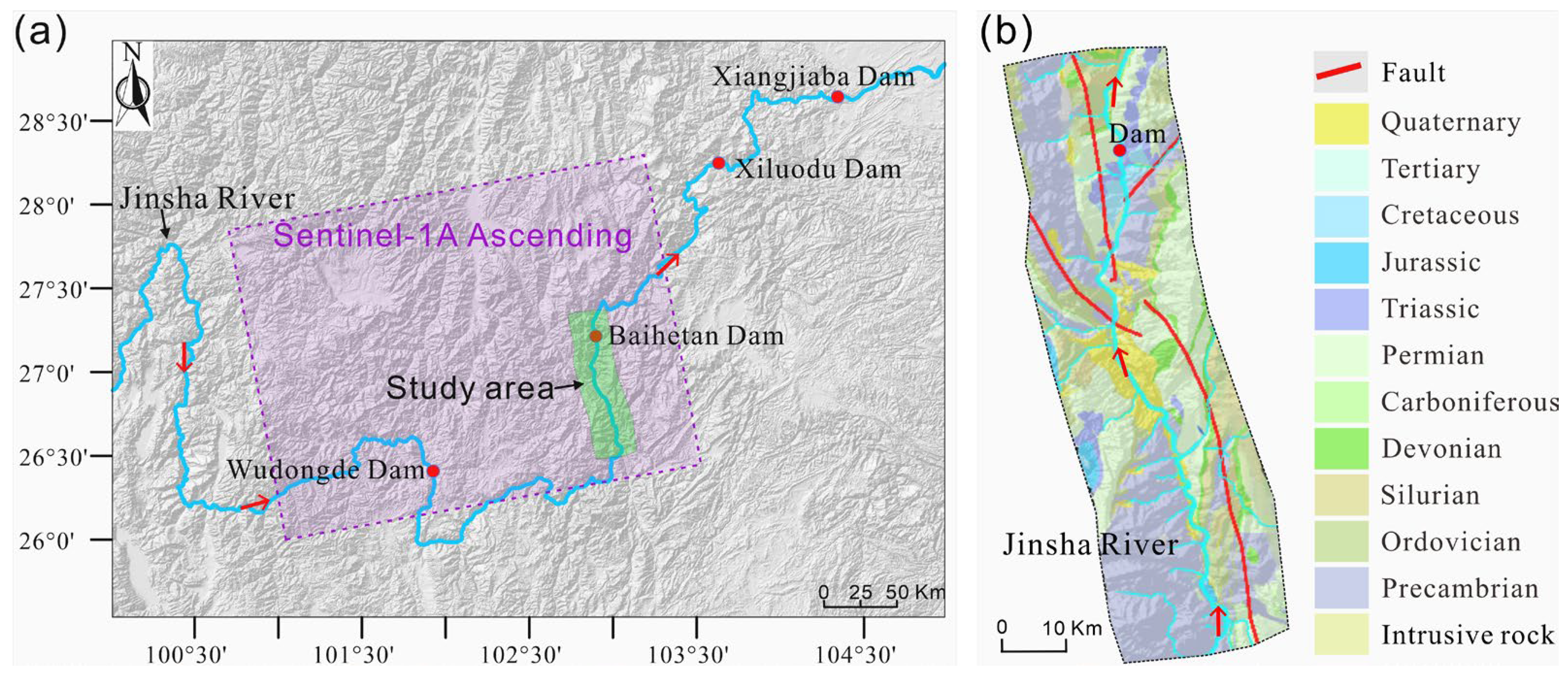

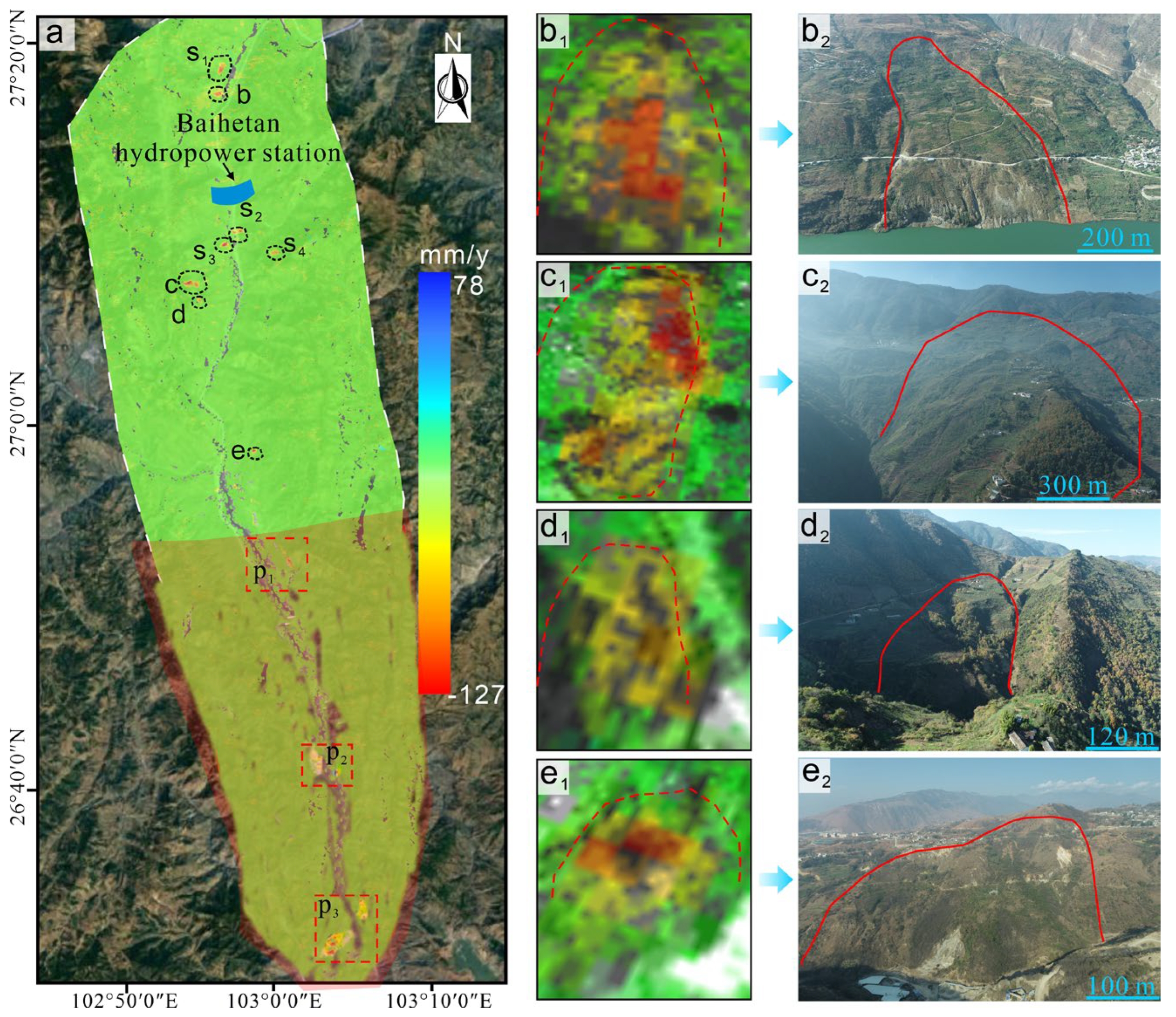



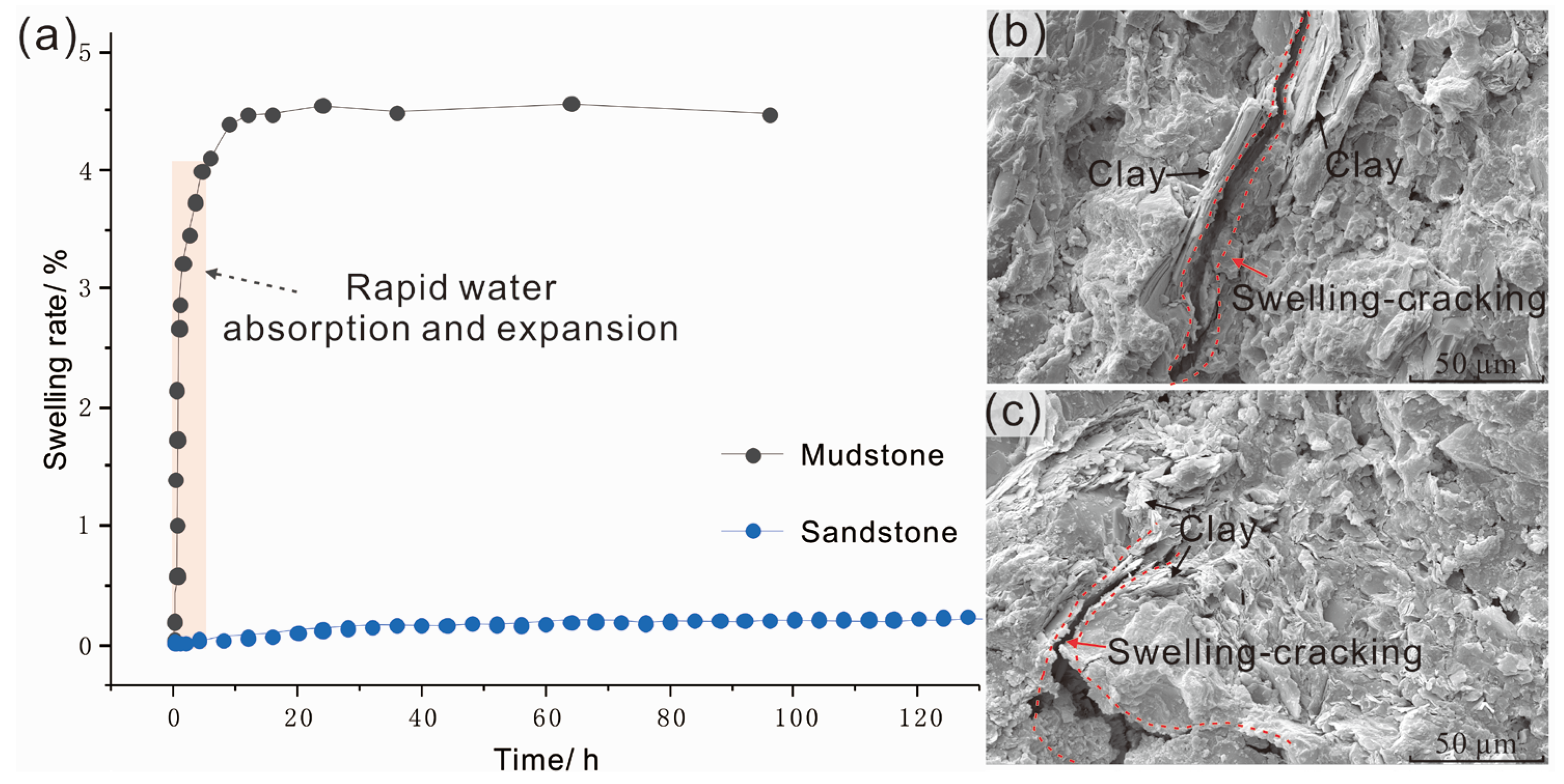
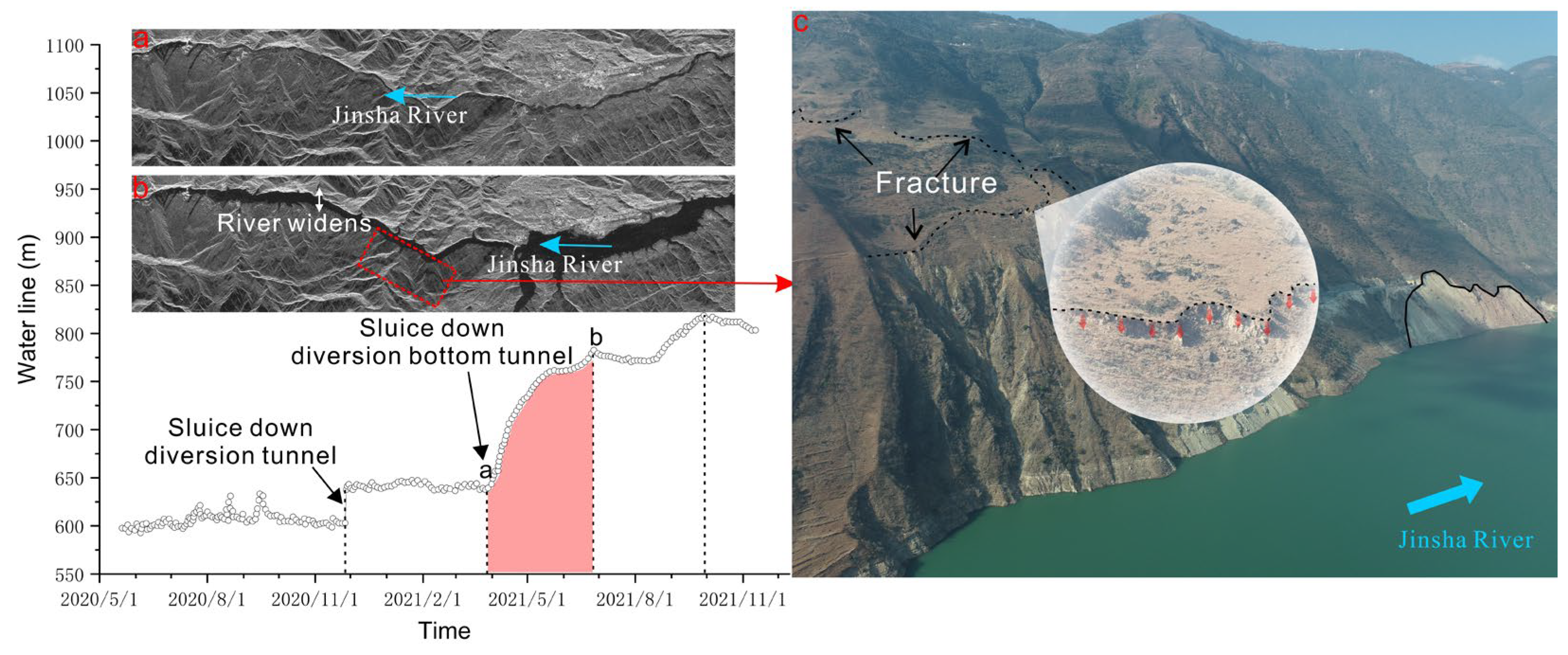
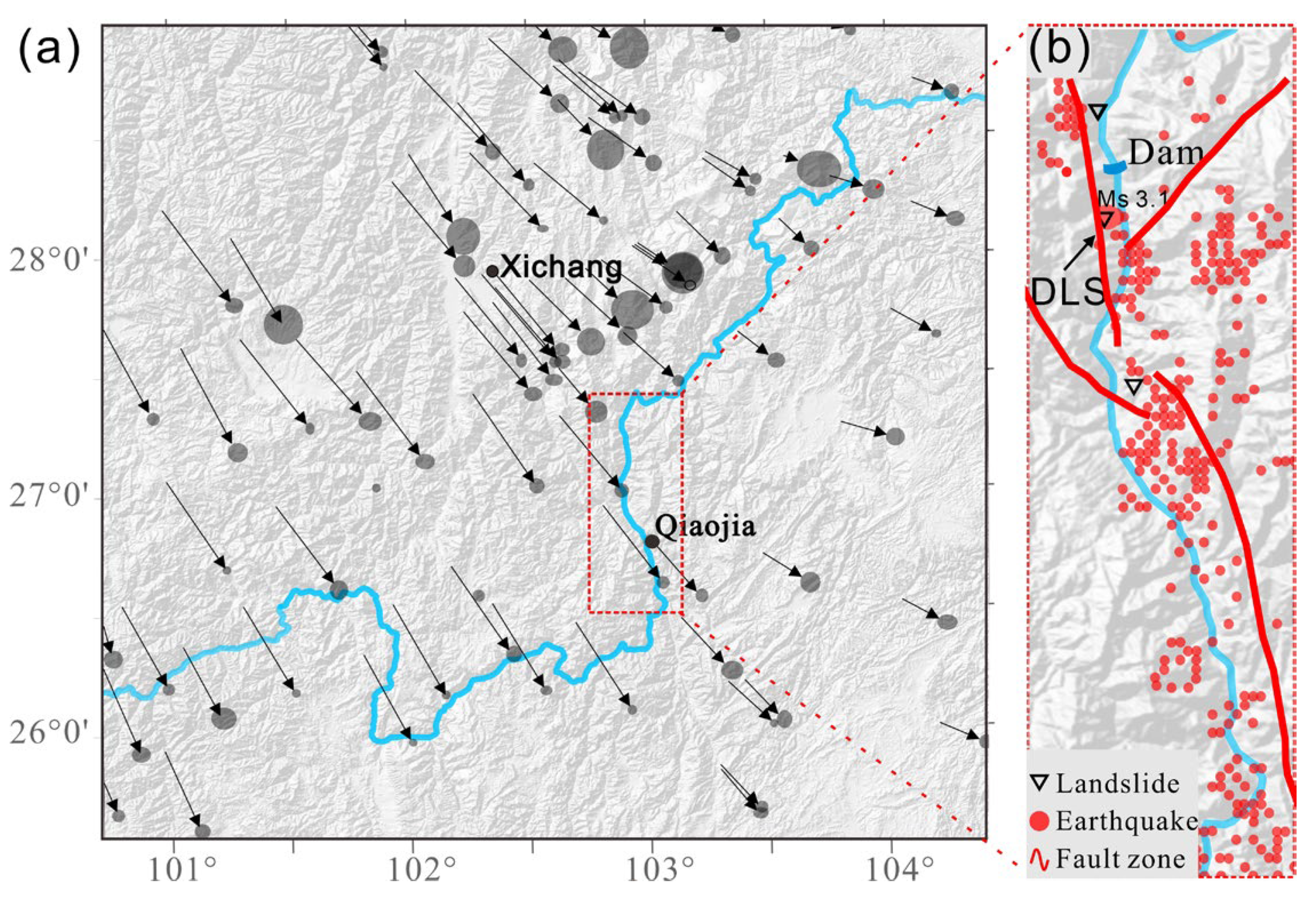
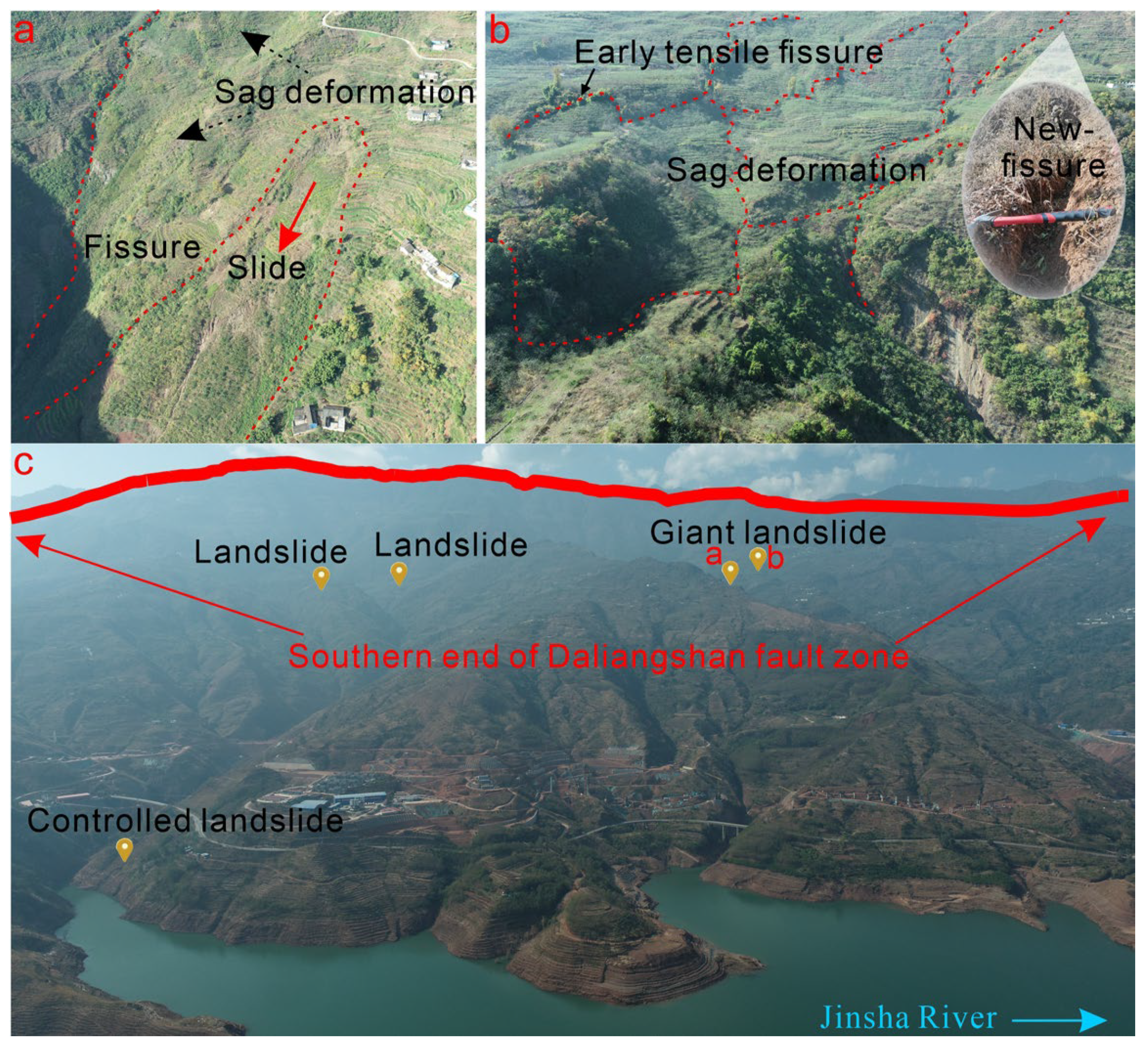
| Parameter | Value |
|---|---|
| Orbit | Ascending and descending |
| Azimuth/range pixel spacing | 13.99 m/2.33 m |
| Radar wavelength | 5.6 cm |
| Polarization mode | VV |
| Revisit period | 12d |
| The angle of incidence | Ascending: 44.13°; descending: 39.62° |
| Temporal coverage | Before impoundment: 2019.01–2021.04 |
| During impoundment: 2021.04–2021.12 |
Disclaimer/Publisher’s Note: The statements, opinions and data contained in all publications are solely those of the individual author(s) and contributor(s) and not of MDPI and/or the editor(s). MDPI and/or the editor(s) disclaim responsibility for any injury to people or property resulting from any ideas, methods, instructions or products referred to in the content. |
© 2024 by the authors. Licensee MDPI, Basel, Switzerland. This article is an open access article distributed under the terms and conditions of the Creative Commons Attribution (CC BY) license (https://creativecommons.org/licenses/by/4.0/).
Share and Cite
Zhang, S.; Meng, J.; Fu, G. Combining InSAR Technology to Uncover the Deformation Factors and Mechanisms of Landslides in the Baihetan Hydropower Station Reservoir Area. Water 2024, 16, 1511. https://doi.org/10.3390/w16111511
Zhang S, Meng J, Fu G. Combining InSAR Technology to Uncover the Deformation Factors and Mechanisms of Landslides in the Baihetan Hydropower Station Reservoir Area. Water. 2024; 16(11):1511. https://doi.org/10.3390/w16111511
Chicago/Turabian StyleZhang, Shuang, Jie Meng, and Guobin Fu. 2024. "Combining InSAR Technology to Uncover the Deformation Factors and Mechanisms of Landslides in the Baihetan Hydropower Station Reservoir Area" Water 16, no. 11: 1511. https://doi.org/10.3390/w16111511
APA StyleZhang, S., Meng, J., & Fu, G. (2024). Combining InSAR Technology to Uncover the Deformation Factors and Mechanisms of Landslides in the Baihetan Hydropower Station Reservoir Area. Water, 16(11), 1511. https://doi.org/10.3390/w16111511





